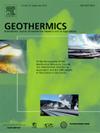犹他州福奇花岗岩裂缝剪切实验研究:对EGS油藏增产的启示
IF 3.5
2区 工程技术
Q3 ENERGY & FUELS
引用次数: 0
摘要
从干热岩石到工作流体的有效热传递需要裂缝提供的大表面积。这些裂缝可能既包括张性水力裂缝,也包括天然剪切裂缝和断层。维持裂缝的流动对于增强型地热系统(EGS)的性能至关重要。在众多先前的研究中,仍然缺乏实验室测量来量化地热储层在热、水力、机械和化学(THMC)耦合环境下的剪切裂缝演化。为了解决这个问题,我们对来自犹他州米尔福德犹他州地热能研究前沿观测站(Utah- forge)的晶体花岗岩样品进行了三轴直接剪切试验。在犹他- forge现场的原位条件下,我们测量了剪切滑移前后的裂缝渗透率、孔径、强度、变形和流出物化学成分——复制了应力、压力、温度、矿物学和注入水化学成分。我们的研究结果表明,剪切位移可以将裂缝渗透率提高一个数量级(系数为~ 10);然而,在某些情况下,由于断层泥的形成、化学蚀变、应力循环和表面粗糙度的变化,渗透率下降了两个数量级(系数为0.01)。我们的测试还表明,原位剪切可能会产生光滑的平面剪切面(例如,膨胀角<;7°),类似于滑面,这降低了剪切压裂增产的效益。流出物分析证实了FORGE样品中硅酸盐和岩盐矿物的快速溶解和镁的沉淀,特别是在剪切刺激之后。我们的工作为模拟Utah-FORGE和类似的花岗岩地热远景提供了关键的新测量方法。本文章由计算机程序翻译,如有差异,请以英文原文为准。
Experimental investigation of shear in granite fractures at Utah FORGE: Implications for EGS reservoir stimulation
Efficient heat transfer from hot dry rock to a working fluid requires the large surface area provided by fractures. These fractures are likely to include both tensile hydraulic fractures and natural shear fractures and faults. Maintaining flow through these fractures is vital for the performance of Enhanced Geothermal Systems (EGS). Among numerous prior studies, there remains a lack of laboratory measurements to quantify shear fracture evolution in the coupled thermal, hydraulic, mechanical, and chemical (THMC) environment of a geothermal reservoir. To address this, we conducted triaxial direct-shear tests on crystalline, granitic rock samples from the Utah Frontier Observatory for Research in Geothermal Energy (Utah-FORGE) site in Milford, Utah. We measured fracture permeability, aperture, strength, deformation, and effluent chemistry before and after shear slip under in-situ conditions at the Utah-FORGE site – replicating stress, pressure, temperature, minerology, and injectate water chemistry. Our results show that shear displacement can increase fracture permeability by up to an order of magnitude (factor of ∼10); however, in some cases, permeability decreased by up to two orders of magnitude (factor of ∼0.01), due to gouge formation, chemical alteration, stress cycling, and changes in surface roughness. Our tests also indicate in-situ shear is likely to produce smooth-planar shear surfaces (e.g., dilation angles <7°), akin to slickensides, which reduces the benefit of shear fracture stimulation. Effluent analysis confirms rapid silicate and halite mineral dissolution and magnesium precipitation on FORGE samples, especially after shear stimulation. Our work provides key new measurements for modelling Utah-FORGE and similar granitic geothermal prospects.
求助全文
通过发布文献求助,成功后即可免费获取论文全文。
去求助
来源期刊

Geothermics
工程技术-地球科学综合
CiteScore
7.70
自引率
15.40%
发文量
237
审稿时长
4.5 months
期刊介绍:
Geothermics is an international journal devoted to the research and development of geothermal energy. The International Board of Editors of Geothermics, which comprises specialists in the various aspects of geothermal resources, exploration and development, guarantees the balanced, comprehensive view of scientific and technological developments in this promising energy field.
It promulgates the state of the art and science of geothermal energy, its exploration and exploitation through a regular exchange of information from all parts of the world. The journal publishes articles dealing with the theory, exploration techniques and all aspects of the utilization of geothermal resources. Geothermics serves as the scientific house, or exchange medium, through which the growing community of geothermal specialists can provide and receive information.
 求助内容:
求助内容: 应助结果提醒方式:
应助结果提醒方式:


